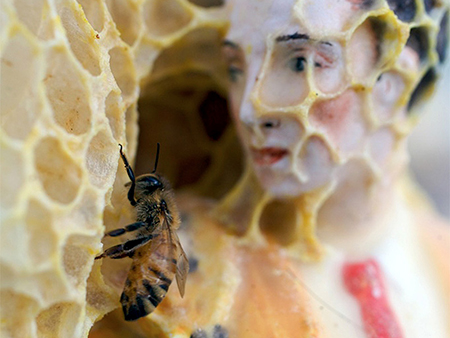Animal Intent (Exhibition)
 When: Fri., Mar. 17, 2017 at 11:00 am - 6:00 pm
When: Fri., Mar. 17, 2017 at 11:00 am - 6:00 pmWhere: apexart
291 Church St.
212-431-5270 Price: FREE
Buy tickets/get more info now
See other events in these categories:
 On view January 19–March 18, 2017
On view January 19–March 18, 2017
Organized by Emily Falvey
Tracking how animal culture inspires a range of artistic practices focused primarily on interspecies communication, this exhibition questions whether creative labor is strictly a human trait.
Featuring work by:
Annie Dunning
Aganetha Dyck
William Eakin
Nina Katchadourian
Alison Reiko Loader & Christopher Plenzich
—
“We pre-suppose labor in a form that stamps it as exclusively human. A spider conducts operations that resemble those of a weaver, and a bee puts to shame many an architect in the construction of her cells. But what distinguishes the worst architect from the best of bees is this, that the architect raises his structure in imagination before he erects it in reality.”
— Karl Marx, Capital, Vol. I
A humanist truism states that there is no art in the non-human world. And yet, there is much that is not human in art. Indeed, art history often begins with depictions of animals (usually the iconic horses of Lascaux Caves), as well as objects made from their bodies, such as etched shells, or carved bones and teeth. While assuming that such images and artifacts inaugurate an uninterrupted aesthetic evolution spanning human existence is questionable, it is nonetheless tempting to see in them one of art’s formative paradoxes: borne of our closeness with animals, it also marks our movement away from them.
While our relationship with animals has changed more in the last 200 years than in all of human history, animals continue to play an important role in contemporary art, usually as symbols of a social imaginary or as indexes of the real. In the first case, they tend to embody positive and negative attitudes towards shared cultural mores, institutions, and values. In the second, their actual bodies – documented, confined, taxidermied – confront us with the limits of this imaginary, which subjugates animals while simultaneously failing to grasp their otherness.
Although contemporary art continues to be defined by human activities, the notion of “animal culture” now serves as a point of departure for a range of artistic practices focused primarily on interspecies communication. Rather than merely representing animals, or using them as surrogates, such practices partner with non-humans in the creation of unique aesthetic languages. Annie Dunning, for example, conflates human and “woodpecker culture,” creating interactive sound sculptures from a pattern of holes made by a yellow-bellied sapsucker. Alison Reiko Loader and Christopher Plenzich mix etymology and media art in an interspecies project that harnesses the creative potential of forest tent caterpillars. Aganetha Dyck works collaboratively with honeybees, placing found objects in their hives and waiting as they are transformed into intricate, honeycombed sculptures. In a sort of inverse collaboration, Nina Katchadourian mends spiders’ webs with sewing thread, only to have these interventions systematically rejected and replaced with new constructions created by the spiders. Michael Anthony Simon, on the other hand, brings Nephila clavata spiders to his studio where they are invited to make webs of their own design. Once completed, these delicate constructions are fixed with spray paint, thus highlighting their aesthetic complexities, while also conferring upon them an artistic status somewhere between painting and sculpture.
Inspired by the above quote from Marx, the proposed exhibition will question the validity of anthropocentric theories of creative labor. It will thus focus on artistic projects that establish a creative partnership with non-humans, thereby emphasizing the aesthetic intention of animals, as well as the possibilities, limits, and ethics of interspecies collaboration.
For more information, visit: https://apexart.org/exhibitions/falvey.php
Buy tickets/get more info now